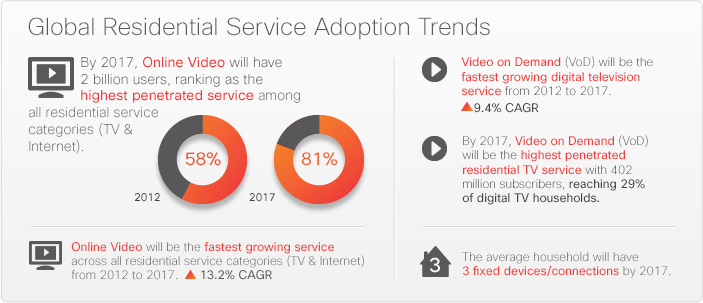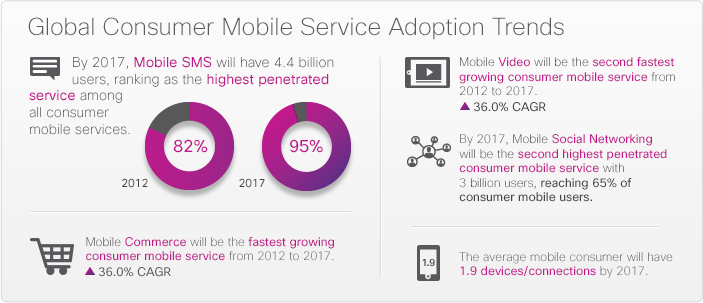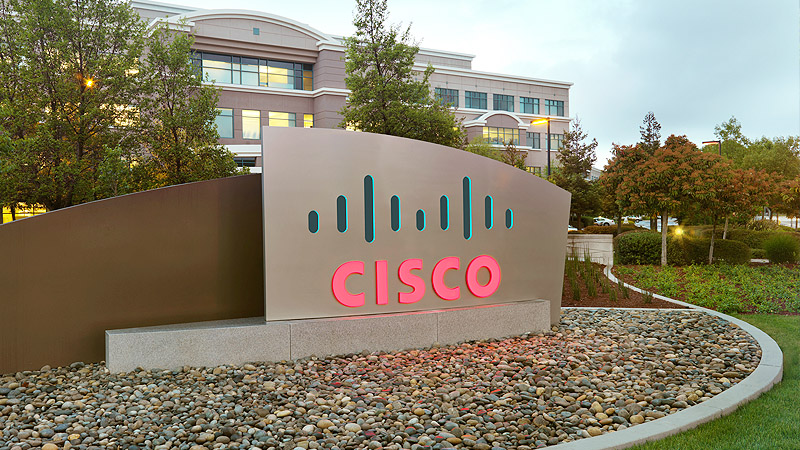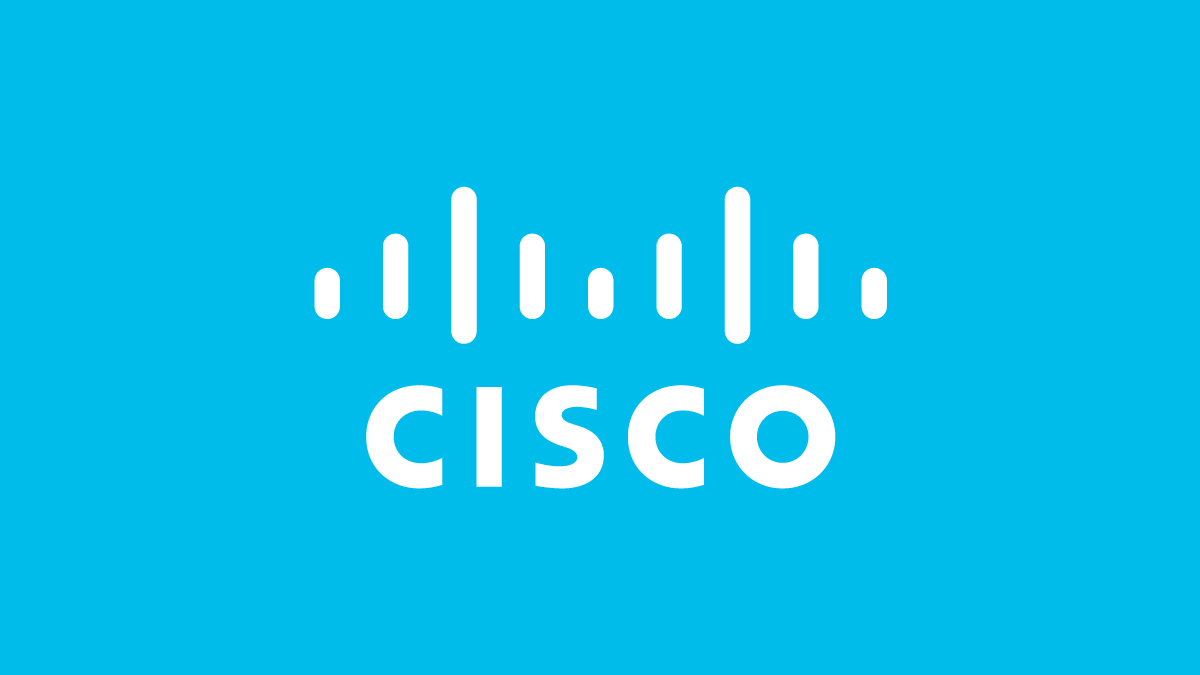SAN JOSE, Calif. – May 29, 2013 – The Cisco® Visual Networking Index (VNI) Forecast (2012-2017), published today, projects that global Internet protocol (IP) traffic will grow three-fold between 2012 and 2017. Global IP traffic (fixed and mobile) is expected to reach an annual run rate of 1.4 zettabytes ― more than a trillion gigabytes per year – by 2017. On a monthly basis, global IP traffic is expected to reach nearly 121 exabytes per month by 2017, up from about 44 exabytes per month in 2012. (121 exabytes is equivalent to 30 billion DVDs; or 28 trillion MP3's; or 750 quadrillion text messages.) This updated study includes global fixed IP traffic growth and service adoption trends, complementing the VNI Global Mobile Data Traffic Forecast released earlier this year.
Global IP Traffic Drivers
More Global Internet Users
- By 2017, there will be about 3.6 billion Internet users—more than 48% of the world's projected population (7.6 billion).
- In 2012, there were 2.3 billion Internet users—about 32% of the world's population (7.2 billion).
More Global Devices/Connections
- By 2017, there will be more than 19 billion global network connections (fixed/mobile personal devices, M2M connections, et al.), up from about 12 billion connections in 2012.
Faster Global Fixed Broadband Network Speeds
- Globally, the average fixed broadband speed will increase 3.5-fold from 2012 – 2017, from 11.3 Mbps to 39 Mbps.
- Globally, the average fixed broadband speed grew 30% from 2011 – 2012, from 8.7 Mbps to 11.3 Mbps.
Increased Global Use of Video Services/Applications
- Global network users will generate 3 trillion Internet video minutes per month, that is 6 million years of video per month, or 1.2 million video minutes every second or more than two years worth of video every second.
- Globally, there will be nearly 2 billion Internet video users (excluding mobile-only) by 2017, up from 1 billion Internet video users in 2012.
In 2012, 26% of Internet traffic originated with non-PC devices, but by 2017 the non-PC share of Internet traffic will grow to 49%. PC-originated traffic will grow at a 14% CAGR, while other devices/connections will have higher traffic growth rates over the forecast period―TVs (24%), tablets (104%), smartphones (79%), and machine-to-machine (M2M) modules (82%).
As global service providers build out the Next Generation Internet, nearly half of the world's population will have network and Internet access by 2017. The average Internet household (globally) will generate 74.5 gigabytes per month. By comparison, in 2012, the average Internet household generated 31.6 gigabytes of traffic per month.
The Forecast also reveals that the "Internet of Things" (the networked connection of physical objects) is showing tangible growth and will have a measurable impact on global IP networks. Globally, M2M connections will grow three-fold from two billion in 2012 to six billion by 2017. Annual global M2M IP traffic will grow 20-fold over this same period—from 197 petabytes in 2012 (0.5% of global IP traffic) to 3.9 exabytes by 2017 (3% of global IP traffic). Applications such as video surveillance, smart meters, asset/package tracking, chipped pets/livestock, digital health monitors and a host of other next-generation M2M services are driving this growth.
Summary of Key Takeaways from the VNI Forecast
Global IP Traffic Projections and Analysis
- By 2017, annual global IP traffic will reach 1.4 zettabytes (23% CAGR from 2012 to 2017). – A zettabyte is equal to a sextillion bytes.
- By 2017, more traffic will traverse global networks than all prior "Internet years" combined:
- 1984 – 2012: 1.2 zettabytes
- 2017 Forecast: 1.4 zettabytes
- "Busy hour" Internet traffic, (hours of the day during which traffic is highest), is increasing faster than average Internet traffic. Busy hour Internet traffic increased 41% in 2012, compared to 34% growth in average traffic.
- Metro traffic will surpass long-haul traffic in 2014, and will account for 58% of total IP traffic by 2017. Metro traffic will grow nearly twice as fast as long-haul traffic from 2012 to 2017.
- Content delivery networks (CDNs) will carry over half of total Internet traffic by 2017.
- Wi-Fi and mobile-connected devices will generate 68% of Internet traffic by 2017.
- Nearly half of total IP traffic will originate with non-PC devices (including tablets, smartphones, and televisions) by 2017.
Standout IP Networking Trends
- Fixed/Wi-Fi traffic will grow at a CAGR of 26% between 2012 and 2017, compared to a 16% CAGR for fixed/wired traffic
- Globally, the average household had 4.7 devices / connections (including M2M) in 2012; the average household will have 7.1 devices / connections (including M2M) by 2017 (an 8.8% CAGR).
- Globally, there will be 8 billion IPv6-capable fixed & mobile devices/connections in 2017, up from 1.6 billion in 2012 (38% CAGR).
- Globally, 42% of all fixed & mobile networked devices/connections will be IPv6-capable in 2017, up from 14% in 2012.
Regional & Country IP Traffic Projections
- Asia-Pacific (APAC) will generate the most IP traffic by 2017 (43.4 exabytes/month), maintaining its leadership from last year.
- The Middle East and Africa will continue to be the fastest growing IP traffic region from 2012 – 2017 (5-fold growth, 38% CAGR over the forecast period); MEA was the fastest growing region last year as well (10-fold growth, 57% CAGR for the 2011 – 2016 forecast period) in this category.
- By 2017, the highest traffic-generating countries will be the United States (37 exabytes per month) and China (18 exabytes per month).
- For fastest growing IP traffic at the country-level, India will have the highest IP traffic growth rate with a 44% CAGR from 2012 – 2017. Second is Indonesia (42% CAGR) and third is South Africa (31% CAGR) over the forecast period.
Regional IP Traffic Growth Breakouts
- APAC: 43.4 exabytes/month by 2017, 26% CAGR, 3-fold growth
- North America: 40.7 exabytes/month by 2017, 26% CAGR, 3-fold growth
- Western Europe: 24.3 exabytes/month 2017, 17% CAGR, 2-fold growth
- Central Europe: 8.8 exabytes/month by 2017, 21% CAGR, 3-fold growth
- Latin America: 7.4 exabytes/month by 2017, 17% CAGR, 2-fold growth
- Middle East and Africa: 3.5 exabytes/month by 2017, 38% CAGR, 5-fold growth
Key Consumer and Business Forecast Projections:
Global Consumer Internet Video Consumption
- Globally, there will be nearly 2 billion Internet video users (excluding mobile-only) by 2017, up from 1 billion Internet video users in 2012.
- Internet video-to-TV traffic will increase nearly 5-fold between 2012 (1.3 exabytes per month) and 2017 (6.5 exabytes per month).
HD and 3D Internet Video Traffic
- By 2017, 3D and HD Internet video will comprise 63% of consumer Internet video traffic.
- Advanced consumer Internet video (3D and HD) will increase 4-fold between 2012 and 2017.
Global Consumer VoD Traffic
- VoD traffic will increase 3-fold between 2012 and 2017.
Global Consumer Internet File Sharing Traffic
- Peer-to-peer (P2P) traffic will decline at a CAGR of -9%, while web-based and other file sharing traffic will grow at CAGR of 17% from 2012 – 2017.
- By 2017, global P2P traffic will be 65% of global consumer Internet file sharing traffic, down from 85% in 2012.
Global Business IP Traffic
- Overall business IP traffic, which includes Internet, backup, VoIP, etc., will nearly triple between 2012 and 2017.
- In 2012, business IP traffic represented 20% of monthly total global IP traffic (consumer IP traffic represented 80% of monthly total global IP traffic).
- By 2017, business IP traffic will represent 18% of monthly total global IP traffic (consumer IP traffic will represent 82% of monthly total global IP traffic).
Global Business Internet Video Traffic
- Business Internet video traffic will from 5.3-fold from 2012 to 2017.
- Business Internet video traffic grew 52% in 2012.
- Video will account for 58% of all business Internet traffic in 2017, up from 31% in 2012.
VNI Service Adoption Highlights
Also available today, and paired with the VNI research results, is Cisco's complementary study ―the Cisco VNI Service Adoption Forecast, which includes global and regional residential, consumer mobile, and business services growth rates.
Topline
- Globally, the population was 7,160 million in 2012 and will reach 7,563 million by 2017 (1.1% CAGR).
- Globally, there were 1,996 million households in 2012; there will be 2,167 million households by 2017 (1.7% CAGR).
Residential
- Globally, there were 1,832 million residential Internet users with fixed Internet access in 2012; there will be 2,459 million residential Internet users with fixed Internet access by 2017 (6.1% CAGR).
- Globally, there were 1,598 million TV households in 2012; there will be 1,744 million TV households by 2017 (1.8% CAGR).
Consumer Mobile
- Globally, there were 3,789 million mobile consumers in 2012; there will be 4,635 million mobile consumers by 2017 (4.1% CAGR).
Business
- Globally, there were 1,408 million business Internet users in 2012; there will be 1,965 million business Internet users by 2017 (6.9% CAGR).
- Globally, there were 495 million business mobile users in 2012; there will be 565 million business mobile users by 2017 (2.7% CAGR)
Supporting Quote
- Doug Webster, vice president of product and solutions marketing, Cisco
"Cisco's VNI Forecast once again showcases the seemingly insatiable demand for bandwidth around the globe and provides insights on the architectural considerations necessary to deliver on the ever-increasing experiences being delivered. With more and more people, things, processes and data being connected in the Internet of Everything, the intelligent network and the service providers who operate them are more relevant than ever."
Cisco VNI Forecast Online Resources & Tools
- The updated Cisco VNI Forecast Highlights Tool provides key forecast predictions in short sound bites that can be chosen on a global, regional or country level (these include device, traffic and network speed projections).
- The Cisco VNI Forecast and Methodology, 2012 – 2017 White Paper provides the full detailed findings of the study.
- The Cisco VNI Forecast widget provides customized views of the growth of various network traffic types around the globe (revised for this 2012 - 2017 forecast period).
- The Cisco VNI Service Adoption Forecast White Paper provides a unique view into global and regional trends of next-generation residential, consumer mobile, and business end-user services and applications, underlying addressable markets and relevant devices and connections.
- The Cisco VNI Service Adoption Forecast Highlights Tool provides primary global and regional takeaways on user and subscriber, device and connection, and service adoption penetration rates.
- Cisco's Mobile Service Provider Abstract Network (M-SPAN) and Cable/Telco Service Provider Abstract Network (CT-SPAN) tools enable network operators to generate their own forecasts based on the VNI methodology and assumptions.
- The Cisco VNI Forecast mobile application enables iPhone and Android smartphone users to view global, regional, and select country-level forecast highlights from their devices.
- The Cisco Data Meter mobile application enables iOS and Android smartphone and tablet users to easily monitor their cellular and wi-fi data usage, test the performance of their network connection and more.
Supporting Resources
- Cisco Visual Networking Index home page
- Join Cisco's VNI Forecast 2012-2017 webcast forum discussion featuring key findings, at 8:00 a.m. (PDT) at: http://cs.co/9007XIMx
- The inaugural VNI Service Awards program will announce the top five winners on May 30, 2013. Cisco received 50 inspirational stories across 108 countries.
- To access VNI Forecast 2012-2017 B-roll: http://www.corpbroll.com/broll/cisco; Login required; Access via ‘PR' link
- For more information about Cisco's service provider news and activities visit the SP360 Blog, follow us on Twitter @CiscoSPVideo, hashtag #VNI or SP360 SlideShare
*Editor's Note
Cisco welcomes press, analysts, bloggers, service providers, regulators and other interested parties to use and reference our research with proper attribution, such as "Source: Cisco Visual Networking Index Forecast, 2012-2017."
Tags/Keywords
Cisco, broadband speed, exabyte, IPv6, mobile data, Service Providers, Visual Networking Index, VNI, VNI Forecast, IP traffic, Internet video, networked devices, Doug Webster, zettabyte
RSS Feed for Cisco: http://newsroom.cisco.com/dlls/rss.html
About Cisco
Cisco (NASDAQ: CSCO) is the worldwide leader in IT that helps companies seize the opportunities of tomorrow by proving that amazing things can happen when you connect the previously unconnected. For ongoing news, please go to http://thenetwork.cisco.com.
# # #
Cisco and the Cisco logo are trademarks or registered trademarks of Cisco and/or its affiliates in the U.S. and other countries. A listing of Cisco's trademarks can be found at www.cisco.com/go/trademarks. Third-party trademarks mentioned are the property of their respective owners. The use of the word partner does not imply a partnership relationship between Cisco and any other company.
References











